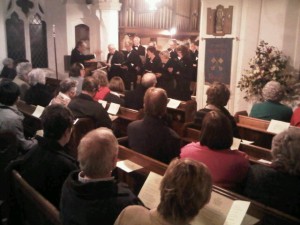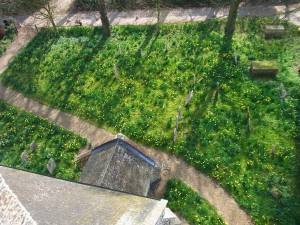The Cuckoos are on their way here. In the next few days someone in the valley should hear their first call. They need a steady southerly wind to ease the trip and the current south-easterlies are probably not quite enough. Some idea of their journey can be gauged by following this link to the British Trust for Ornithology’s satellite tracking of Norfolk Cuckoos http: //www.bto.org/science/migration/tracking-studies/cuckoo-tracking It will be interesting to see how they and the start of the local calls coincide.
-
Waiting for the Cuckoo
-
Roebuck
The grass on the fallow land is becoming more palatable. The evidence was the presence of a young Roebuck on Mr Crane’s land. The railway line lay between the buck and home. As he caught sight of me, he took to his heels in a wide arc around the field, I stood and waited. Perhaps he would clear the railway fence in a fine arching leap? But no as he approached the fence he gingerly explored up and down until, on finding a slack section of fence he carefully negotiated his way through and slipped back towards Keeper’s Wood.
-
Marauding hawk
It was the alarm call of a Partridge that drew my attention. Although as a game species they are prone to raising such alarms, this one was clearly serious. It was flying arrow straight, wings whirring and at about 10 ft in altitude over the Town Field. Slightly above and behind the Partridge was the cause of the furore, a large female Sparrowhawk. The Sparrowhawk was intent on it’s prey and it initially failed to notice that it was itself being pursued by a Carrion Crow. But when it did it veered and climbed leaving the Partridge to fight for another day. Small dramas on a quiet spring morning.
-
Hawk corridor
Tension spreads by insistent alarm calls from songbirds. It was a morning of small drama along the railway line. The cause of the electric atmosphere was a male Sparrowhawk; the hunter weaves from along the Blackthorn in a hedge-hugging flight alternating between powerful rowing wing beats and fast glides. Every few yards he swings from one side of the hedge to the other. Never more than two feet above it, I felt I could see his cold yellow concentrated eye as he sped along. In fact the hunting pass is over in seconds and the finches had all successfully dived for cover. The panic continues like a corridor ahead of him, whilst in his wake wildlife visibly relaxes and returns to normality.
-
Nonsuch at Brampton
Choral music by composers spanning five centuries graced Brampton Church on Saturday night. The twenty strong Hickling-based choir, the Nonsuch Singers, under the Guidance of the urbane Dominic Vlasto, sang works by the sixteenth century composer Orlando Lassus, William Byrd, Vaughan-Williams and Billy Joel amongst many others. Choral pieces were interspersed with readings of short pieces by Bernard Levin, Evelyn Waugh and some authentically delivered Noel Coward musings. The Coward readings alone would have been highlight enough if it was not for the genuine pleasure in hearing a choir in the nave of Brampton church. The church was full and the evening ended with a splendid light buffet. The lack of a proper car park at the church did led to an inevitable excitement at the end of the evening, but all in all the evening was a highlight and a great success.

The Nonsuch Singers in full flow -
Green fuse
Bud burst is nearly upon us. Hawthorn and Elders in the hedges and Willows on the Common are all showing the emergent tips of fresh leaves. Ash trees on the railway line are also starting to stir, but they tend to take a long time – obviously not in a hurry in their annual race with the Oaks. The poet Larkin compared this emergent stage to “something almost being said” and you do get the feeling of Spring being on the verge of a new stage.

Lent lilies at Brampton Church In the Churchyard, the Daffodils (or Lent Lilies) are absolutely at their peak, just in time to welcome everybody for this evenings Spring choral concert. Outside the Church workmen are digging up the road in a perhaps less welcome sign of the season.
-
Frog chorus
From the ditches comes a chorus of courting frogs. The adults gather in the still waters in the gin clear water and the calls (not really croaks) can be heard if you wait quietly on a footbridge. The real business of mating takes place at night, but completion carries on sporadically all day.
The frogs have benefitted immensely from the closure of the Marsham crossroads. Their wanderings which involve many in the crossing of roads, including those at the lower end of the village, result in carnage on most years, but this year the traffic pressure is off. Should be a bumper year for tadpoles.
-
Marsh sounds
This morning’s soundscape was dominated by geese and Oystercatchers. The geese being a mix of Canada’s, Greylags and a lone Ruddy Shelduck (presumably an escape from a wildfowl collection). Their collective noise a mix of farmyard honks and squawks.
The Oystercatchers were involved in more serious courtship rituals. Two (males) call musically in their pursuit of a less than keen female – or at least that is how I saw it. Eventually the loser took-off, climbed and circled in pursuit of another potential companion, calling regularly as it drifted over Upper Brampton.
-
Daws at dawn
Just after dawn on Sunday, it was the calls of Jackdaws rather than the a song bird chorus which rang through the village. They favour the dead Elm at the top of the hill, which must stand out to them as a landmark once they have left the roosts at Oxnead. The Jackdaws accompany the slower and more direct flight of Rooks as they stream westwards. The exodus starting as soon as light levels permit, earlier and earlier each morning. As a species the Jackdaw seems to revel in flight, something to be enjoyed rather than just a method of getting there. Their gathering at the Elm being their equivalent of the bikers meeting at a favourite cafe.
-
Low flow
This morning the Bure sits high in her banks. This is thanks to the Mill and lock operators who are helpfully holding up the flow in order to preserve the limited resource. According to Dr Briscoe’s weather recordings (http://www.buxton-norfolk.co.uk/weather.htm ) we have had only 7 inches worth out of an average of 12 inches of rainfall for the period from October to February inclusive. In other words we are 32% below average. Without some retention of flow or some pumped supply from groundwater reserves, the river would be a mere stream at best.
The other bad news for the Bure and in particular it’s fish stocks is the growing population of Cormorants. Last year numbers of visiting birds were particularly high. If they really do eat a pound of fish per day as we are told, I suspect that fish numbers in the Bure were damaged considerably.
